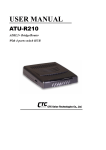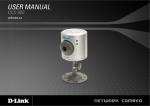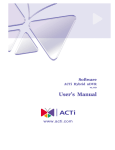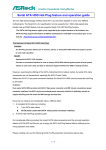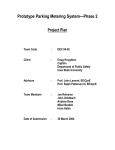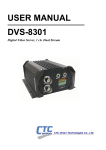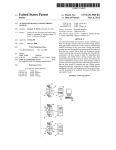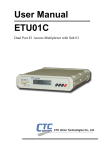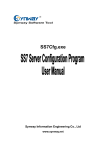Download SmartView Express User Manual
Transcript
USER MANUAL SVP Express An Intelligent Surveillance System CTC Union Technologies Co., Ltd. LEGAL The information in this publication has been carefully checked and is believed to be entirely accurate at the time of publication. CTC Union Technologies assumes no responsibility, however, for possible errors or omissions, or for any consequences resulting from the use of the information contained herein. CTC Union Technologies reserves the right to make changes in its products or product specifications with the intent to improve function or design at any time and without notice and is not required to update this documentation to reflect such changes. CTC Union Technologies makes no warranty, representation, or guarantee regarding the suitability of its products for any particular purpose, nor does CTC Union assume any liability arising out of the application or use of any product and specifically disclaims any and all liability, including without limitation any consequential or incidental damages. CTC Union products are not designed, intended, or authorized for use in systems or applications intended to support or sustain life, or for any other application in which the failure of the product could create a situation where personal injury or death may occur. Should the Buyer purchase or use a CTC Union product for any such unintended or unauthorized application, the Buyer shall indemnify and hold CTC Union Technologies and its officers, employees, subsidiaries, affiliates, and distributors harmless against all claims, costs, damages, expenses, and reasonable attorney fees arising out of, either directly or indirectly, any claim of personal injury or death that may be associated with such unintended or unauthorized use, even if such claim alleges that CTC Union Technologies was negligent regarding the design or manufacture of said product. TRADEMARKS Microsoft is a registered trademark of Microsoft Corp. HyperTerminal™ is a registered trademark of Hilgraeve Inc. User Manual Version 1.0 Oct 2007 First Release This manual supports the following: SVP-Express This document is the first official release manual. Please check CTC Union's website for any updated manual or contact us by E-mail at [email protected]. Please address any comments for improving this manual or to point out omissions or errors to [email protected]. Thank you. CTC Union maintains a support web site (support.ctcu.com) where you may obtain the latest manual, quick installation guide, and operational firmware. Membership to this web site is free, however, you must be a registered member in order to access any software updates. CTC Union Technologies Co., Ltd. 2008 Copyright, All rights reserved. 1 BEFORE USING THIS PRODUCT This CTC Union product has been designed with safety in mind. However, if not used properly, electrical products can cause fires which may lead to serious bodily injury. To avoid such accidents, be sure to heed the following. Legal Caution: Video and audio surveillance may be forbidden by laws that vary from country to country. Please check the laws in your local region before using this product for surveillance purposes. Heed the safety precautions Be sure to follow the general safety precautions and the “Operation Notice.” In case of a breakdown In case of system breakdown, discontinue use and contact your authorized CTC Union dealer. In case of abnormal operation • If the unit emits smoke or an unusual smell, • If water or other foreign objects enter the cabinet, or • If you drop the unit or damage the cabinet: 1 Disconnect the cable and the connecting cables. 2 Contact your authorized CTC Union dealer or the store where you purchased the product. Operation Notice - Operating or storage location Avoid operating or storing this unit in the following locations: • Extremely hot or cold places (Operating temperature: 0 °C to +50 °C [32 °F to 122°F]) • Exposed to direct sunlight for a long time, or close to heating equipment (e.g., near heaters) • Close to sources of strong magnetism • Close to sources of powerful electromagnetic radiation, such as radios or TV transmitters • Locations subject to strong vibration or shock Ventilation To prevent heat buildup, do not block air circulation around the device. Transportation When transporting the unit, repack it in its original packaging or in materials of equal quality. Cleaning • Use a soft, dry cloth to clean the external surfaces of the device. Stubborn stains can be removed using a soft cloth dampened with a small quantity of detergent solution, then wipe dry. • Do not use volatile solvents such as alcohol, benzene or thinners as they may damage the surface. 2 Contents A. Getting Started A.1. Main Function A.2. System Requirement A.2.1. Client-Server System Structure B. Running the Installation Wizard B.1. SVP Express Server version – Installing B.2. SVP Express Client version – Installing B.3. Firewall Configuration C. Control Program C.1. Automatically starts upon system boot up C.2. Shutting Down the Control Program C.3. Start the Control program manually D. Admin Program D.1. Running the Admin Program D.2. Admin Interface Overview D.3. System Management Overview D.3.1. Email Setting D.3.2. Holiday Setting D.3.3. DNS Setting D.3.4. Storage D.3.5. System Alarm D.3.6. Rotation D.3.7. Motion Rectangle D.4. User Group D.4.1. User D.4.2. Group D.5. Area and eMap management D.5.1. Add Area D.5.2. Remove SubArea D.5.3. Rename the Area D.5.4. Remove Area D.5.5. Upload eMap D.5.6. Refresh eMap D.5.7. Resize eMap Icon D.5.8. Device Management (Network Camera, Video Server Controller) D.5.8.1. Network Camera 1 1 1 1 3 3 7 7 7 7 8 8 9 9 10 10 11 12 12 13 15 16 16 17 17 19 21 23 23 23 24 24 24 25 25 26 D.5.8.1.1. Network Camera Button Overview D.5.8.1.2. Network Camera Setting Overview D.5.8.1.3. Remove Network Camera D.5.8.1.4. HW Password D.5.8.1.5. Sensor (Digital Input) D.5.8.1.6. Relay (Digital Output) D.5.8.2. Video Server D.5.8.3. Tools in Menu Bar of eMap interface E. Monitor Program E.1. Running Monitor Program E.2. Monitor Program Interface E.3. Video Display Area E.4. Camera Selection E.5. Display Selection E.5. Local Video Setting E.5.1. Local Record E.5.2. Local Play E.5.3. Local Folder E.5.4. Snapshot E.5.5. Resolution switch while Single camera (CIF/4CIF) E.6. PT Control Interface E.7. System Setting E.7.1. Relay Setting/Cancel Alarm E.7.2. Server Query E.7.3. Alarm On/Off E.7.4. Alarm Query E.7.5. Exit E.8. Alarm eMap E.9. Alarm Notification Log 26 27 34 34 35 36 37 38 39 39 40 40 41 41 41 41 42 43 43 43 43 44 44 45 45 46 46 46 47 A. Getting Started For a better understanding, please read this manual before operate the SVP Express system. A.1. Main Function SVP Express includes the following programs: 1. Control: This program manages video recording, input/output events and alarm triggering; it is running as a background program of SVP Express comes with PC boot up. For detail please refer to Section C. 2. Admin: This program allows you to configure the system of SVP Express and setup the device which connected to system, for detail, please refer to Section D. 3. Monitor: This program allows you to view live video and query recorded file and alarm log, for detail please refer to Section E. 4. Web Monitor: This program allows you to online monitor live video thru IE from client PC, for detail please refer to Section F. A.2. System Requirement SVP Express is consisted of SERVER version and CLIENT version. SERVER version limits one installation, license key are required whenever adding devices for central management. SERVER version includes Admin, Monitor, Control and Web Monitor programs. The CLIENT version is designed for monitoring purpose, and the Admin program is an option while installation (for detail please refer to Section B. Running the Installation Wizard). A.2.1. Client-Server System Structure Page 1 z z System Requirement- SERVER version CPU P-4 3.0G RAM 1G Operating System Windows XP Professional SP2 Network 10/100 Mbps Fast Ethernet Display Card 1024 x 768 (XVGA) or above System Requirement- CLIENT version CPU P-4 1.2G RAM 256 MB or above Operating System Windows XP Professional SP2 Network 10/100 Mbps Fast Ethernet Display Card 1024 x 768 (XVGA) or above z Networking Suggestion SVP Express is optimized for small-scale project, simple LAN or simple WAN environment. Place the system behind firewall or IP sharing device to efficiently protect this system from hackers’ attack. Page 2 B. Running the Installation Wizard B.1. SVP Express Server version – Installing 【Step 1】Please insert SVP Express CD into CD-ROM drive. Go to SVP Express\Server directory to execute Setup.exe. 【Step 2】Select language The Installation Wizard will select the language of your operation system intelligently. SVP Express supports three languages:Traditional Chinese, Simplified Chinese, English 【Step 3】The Installshield Wizard will check if IIS is installed at your system. If not, you can continue installing SVP Express, but you will not be able to use the WEB monitoring feature without IIS. To Install IIS, do the following, 1. Click “Start”. 2. Go to Control Panel Æ Add/Remove Program 3. Click Add/Remove Windows Component 4. Check Internet Information Services (IIS) 5. Click “Next”. 6. Click “Finish”. During the installation process, you may need Microsoft Windows Operating System CD. Page 3 【Step 4】Click “Next” to begin the installation process. 【Step 5】Please read the License Statement and select “Yes” to accept and continue. Page 4 【Step 6】 【Step 7】 【Step 8】 Page 5 【Step9】 【Step10】 【Step11】 Page 6 【Step 12】Installshield Wizard Complete; click “Finish” to complete the setup. The system should start SVP Express in 1 to 3 minutes, and the icon of UARGControl ( ( ) and WatchDog ) appear in task bar of screen’s lower-right corner. 【Note】If in real case, this does not happen, please restart your computer. B.2. SVP Express Client version – Installing Please insert SVP Express CD into CD-ROM drive. Go to SVP Express\Client directory to execute Setup.exe. 【Note】 (1) You may freely install Client version to whichever computer you want. (2) The rest steps are same as installing Server version. B.3. Firewall Configuration C. Control Program C.1. Automatically starts upon system boot up Only one instance of SVP Express Server’s control program can be running at a time. The computer with the running control program will become a SVP Express Server. After installation, the program can be found in the windows start menu at Start Æ Programs Æ SVP Express Æ Control. The Control program will hide itself automatically after start up and be displayed as an icon in the system tray. Page 7 C.2. Shutting Down the Control Program 【Step 1】Find the Control Program icon in the system tray, and double-click it. The Control Program window will appear. 【Step 2】Click the [X] button in the upper right corner. You will be asked with a dialog “Are you sure you to exit the system?” Click “Yes” to exit the program. C.3. Start the Control program manually Navigate to Start Æ ProgramÆ SVP Express Æ Control. This will start the control program and its icon will appear in the system tray. Page 8 D. Admin Program D.1. Running the Admin Program 【Step1.】Select Start \All Programs \CTC Union-SVP Express \Admin.exe 【Step2】 System Log on window. z Server Location: “127.0.0.1” is the default for local server. If you want to access server from client, then please enter the IP of server to this text box. z User name: If this is the first time you logon, use Administrator as default user name and leave the password blank, then click “OK” to log into the system. z Receive video through server: If you want to remote control SVP Express server from client which is not within intranet, then check this box. 【Note】 Password: The default password of Administrator is blank. It is recommended that you change password for security management, please go to User Group section to change the password. Page 9 D.2. Admin Interface Overview Menu Bar System Setup eMap Interface The System Admin screen is divided into three areas: z The Menu Bar area z The System Setup area z The eMap Interface area If your system does not display the screen properly, please check if your display resolution is at least 1024 x 768, and that the font size is Windows system default. SVP Express does not support font sizes larger than the Windows system default one. [Note] The buttons that appear in the Menu Bar depend on which administration function you are using. For example, when you click the User Group icon in System Setup area, the Menu Bar buttons will show related function accordingly. Details will be explained in the following sections. D.3. System Management Overview Select SystemAdm icon in System Setup Area, you will see the button in Menu Bar change accordingly. Button Use To E-Mail Setting: Specify the email outgoing server for sending security alert. Holiday Setting: Specify the calendar holidays for schedule setting which is not included in weekly routine. DNS Setting: Specify the Domain Name your computer registered for DNS service. Storage: Specify the path and storage for recorded file respectively. System Alarm: Set alarm actions respond to the selected system alarm. Page 10 Rotation: Set the interval for image rotation in Monitor split screen. Motion Rectangle: Set the square size of motion detection. D.3.1. Email Setting 【Step1】By selecting E-Mail button( ) from the Menu Bar. 【Step2】You can specify the email server that will be used when sending security alerts via email. 【Step3】To authenticate on the mail server, check SMPT Authentication and enter your user name and password on the mail server. z Outgoing Server: Enter the mail server which could forward your mail to receiver. Some company mail server set the policy of exchanging email within company only. We suggest you use the mail server of the receiver. z Mail From: It is an email address display in the sending column. Page 11 D.3.2. Holiday Setting 【Step1】By selecting Holiday button from Menu Bar. You may specify any calendar holidays except weekend that may affect the security system settings. 【Note】User could enable alarm service full day during these holidays if you check “Holiday” box in Section D.5.8.1.2. Network Camera Setting – Image Alarm. z Export: If you have installed multi sites with SVP Express server they might require the same holiday setting, you can set on one server first, and use the “Export” function to save holiday setting. z Import: You may update the holiday setting to another SVP Express server, by copying the file to that server and use “Import” to update holiday setting accordingly. z Add: Input a description in the Remark field and click “Add” to add the date to the list box at left. z z Modify: You can select a holiday from the list and use “Modify” to edit it Remove: Click “Remove” to remove it from the list. D.3.3. DNS Setting It is designed for the DNS resolution between SVP Express server and IP device. Your video IP device will connect server via IP address of server if you did not enable DNS Resolution. But your IP device will connect server via Domain Name which your server registered, so that alarm action could be executed. Page 12 【Step1】By selecting DNS Setting button from the Menu Bar, you may specify the Domain Name Server. 【Step2】If your computer gets IP from DHCP service or its IP changes periodically due to the policy of your network administrator, please check “Enable DNS resolution”, so any alert message could be delivered to SVP Express from camera no matter what IP your server is assigned. Enter the Domain Name your computer registered to “DNS of this PC” field. 【Note】Please request a DNS for SVP Express from your MIS. D.3.4. Storage By selecting Storage button from the Menu Bar, you may configure the storage and recycling rule. There is two different areas, namely area 1 (include path1 and storage1) and area 2 (include path2 and storage2): Area 1: is assigned the disk to store recorded data. Area 2: is assigned for the backup purpose, it is an optional service. Page 13 Path1 and Path2 Assigned the disk to store recorded data of Schedule and Alarm. (Alias: suggest to give an alias for the path, so that path could be easily differentiated) Storage1 and Storage2 Set the maximum disk space for recording image. Allocation: The storage allocation should be no less than 2 GB. Threshold: When the image data exceeds 90% of allocation, SVP Express will trigger a warning message to related parties. Threshold no less than 1.8 GB. Reservation: SVP Express will overwrite historical data when it reaches 80% of allocation. Reservation no less than 1.6 GB. Browse: You may change the default path. z Directory: please do not choice the directory which has install the operation system. (Generally C:\ is designated to windows operation system is installation) z Folder: double click the folder which you want to save recorded file, the folder name will display in the “Directory” field, click “OK” to save the setting and folder name will be created by system. 【Note】 Recording video over a long period of time will consume large amounts of disk space. Make sure that you have at least 2GB disk space available if you want to use recording function. Path 2 is assigned for the backup purpose, it is an optional service. If this is configured, identical recording information will be written to both path 1 and path 2. Page 14 D.3.5. System Alarm By selecting System Alarm button from the Menu Bar, you can turn on system diagnosis and alarm action. Alarm Action from three system events: 1. Free space is running short. 2. Device Disconnects. 3. Failed to save recording data Alarm Ring Setting: there are 4 sounds effect to be selected. Any system event will trigger alarm action, please refers to Section D.5.8.1.2. Network Camera Setting – Alarm Action for detail. Page 15 D.3.6. Rotation By selecting Rotation button from the Menu Bar, you can set the camera to assigned split screen and rotation interval. 【Step 1】Select the Tab of split screen, 4CH, 9CH and 16CH. 【Step 2】 Assign camera to split screen: Take 16-splitscreen as example: select Tab of 16CH, and select the split-ed screen (remark the selection by changing color to orange) to move camera from “Unselected Column” to “Selected Column” by clicking button. 【Step 3】Set Rotation Sequence. You can adjust camera sequence by clicking up/down button and also set the rotation frequency by selected interval. D.3.7. Motion Rectangle By selecting Motion Rectangle button from the Menu Bar, you can set the square size of detected area. Page 16 D.4. User Group The User Group functions in System Setup area is for managing user privileges. Default user “Administrator” is created with full privileges during installation. You may add users to the system and differentiate their privilege by designating them to different groups. Button Use To Button Use To Add User User Setting Remove User Add Group Group Setting Remove Group D.4.1. User Add User 【Step 1】Select User icon in the System Setup area, then click the New User button in the Menu Bar. 【Step2】Enter user information in the “General” Tab. 【Note】For security concern, it is recommended to assign Password and tick the box for password changing and validation. Page 17 User Belongs 【Step3】Designating a User to a Group Select the “User Belongs” tab to designate a user to a group. Select the group name and move it between “Selected group” and “Unselected group”. Click “OK” to continue. After setting both general information and user belongs, click “Create” to save the setting. User Setting (Modify) 【Step1】Select User Setting Select User icon in the right, the User Table display in the E-Map Interface area, when select any user icon from the User Table, the User Setting Button will display in the Menu Bar accordingly. Then click in the the Edit User button Menu Bar. 【Step2】Modifying user Information You may change the information by modifying the general information or user belongs of that user. Page 18 D.4.2. Group z z z Admin Group is the user group that has the full privilege to the Admin and Monitor programs. The user of “Administrator”, system default and belong to “Admin Group”, can add users and assign users to whatever user group. Monitor Group is the group for general users that has the full privilege to the Monitor program. User Group is the group for viewing monitor program only. Add Group 【Step1】 Select the User icon in the System Setup area, then click Add User Group button in the Menu Bar to add the user group’ s data. 【Step2】 Give a name to the new group and group the selected users here in one step. Page 19 【Step3】 Select the “Function” tab to designate function to a group. Select the function list and move them from “Unselected function” to “Selected function”. Click “OK” to continue. 【Step4】 After setting both Tab of “General” and “Function”, click “Create” to save the setting. Modify Group 【Step1】Select User Group Select User Group icon in the System Setup area, the User Group Table display in the right area, when select the icon from the User Group Table, the User Group Setting Button will display in the Menu Bar accordingly. Then click the Edit User button in the Menu Bar. 【Step2】Modify User group Information. You may change the information by modifying the general information or function of that user group. Page 20 D.5. Area and eMap management Area refers to the geography and device scope of SVP Express. Area is a prerequisite of any device setting (device includes: video server, Network Camera, camera image, relay or sensor), SVP Express provides multi-areas to meet user different requirement. eMap refers to (1) a hierarchical tree-structured management tool in System Setup area (2) background of the area, it could be a picture or a map (3) an interface which combines eMap background and device icon, eMap visually presents the devices in your security system. To configure a new system, select eMap icon in the System Setup to bring up the Area button in the Menu Bar. Select the newly created area under the eMap branch and use the corresponding menu options to add a Network Camera or Video Server to your system or to upload a background picture to the eMap Interface. Icon Overview Icon Representing Area icon: The first level of the eMap hierarchy, the place to add a device. Video Server:Depending on the device model. There may be an image, a sensor, or a relay under this object. Network Camera:Depending on the device model. There may be an image, a sensor, or a relay under this object Image icon: The image component of a camera. PTZ icon: The image component of a PTZ Dome camera. Relay icon: The image component of a Relay setting. Sensor icon: The image component of a Sensor setting. Page 21 Button Overview When you select eMap icon, Menu Bar will display the following functions: Button Use to Add Area: This button allows you to add a new area under eMap branch. Remove Subarea: This button allows you to remove all areas and devices that are under the eMap branch. When you select the Area icon, Menu Bar will display the following functions: Button Use to Rename the Area: This button allows you to edit a name of a selected area. Remove Area: This button allows you to remove a selected area and all devices in that area. Upload eMap: This button allows you to upload a blueprint or map to a selected area. Refresh eMap: This button allows you to refresh a blueprint or map from your PC to get updated in case a new eMap was uploaded from server or another client access. Resize eMap icon: This button allows you to change the ratio of the device icons to display on the eMap interface. Add Network Camera: This button allows you to add a new IP Cam, Speed Dome and Fix Dome to the area. Add Video Server: This button allows you to add a new video server to the area. Page 22 D.5.1. Add Area 【Step1】Select eMap icon from the System Setup. 【Step2】Click Add Area button from the Menu Bar. An Area Setting window will pop up. Enter the name to the “Area Name” textbox. 【Step3】Click “Create” to save setting, a newly created area demonstrate as following: Before Add Area After Add Area D.5.2. Remove SubArea Select eMap icon, then click the Remove All Areas button . A warning message pops up confirming if you want to remove all areas and devices under area. Click “OK” to confirm. D.5.3. Rename the Area Page 23 Select Area icon, then click the Rename Area button . You can modify this area name. D.5.4. Remove Area Select Area icon, then click the Remove Area button . A warning message pops up to get your confirmation. Click “OK” to confirm. D.5.5. Upload eMap 【Step1】Select Upload eMap button in the Menu Bar. An Upload eMap window will pop up. 【Step2】Click “Browse” to navigate the image file representing the area that you wish to secure, and then click “Upload” button. 【Note】Image files can be in the format of *.jpg, *.gif, *.bmp, *.wmf, *.emf, *.ico. D.5.6. Refresh eMap For the system performance, all the admin setting are kept by cache, so if the server eMap is changed from the client PC, then the others PC, no matter server nor client is, need to refresh the eMap background manually by clicking the Refresh eMap button Page 24 . D.5.7. Resize eMap Icon 【Step1】 Select Device Ratio button in the Menu Bar. A Resize eMap icon window pops up. 【Step2】Select the ratio of device and click “OK”, the icon display in eMap interface will change it’s ratio accordingly. D.5.8. Device Management (Network Camera, Video Server Controller) New device should be added and configured in SVP Express Admin program. The following section will explain the details of network camera and video server. The supported H/W manufactures and models for each device can be found in the SVP Express Hardware Support list. Adding Device (Network Camera / Video Server controller) Add Device 【Step1】Click or button from the Menu Bar to bring up the Device Setting window. Type information to textbox as following: Manufacturer: Device manufacturer. Model: Device model. IP address: IP address from your chosen device you wish to connect to. Port No: The default port number is 80, which can be edited to match with camera web configuration. Location: The naming of newly added device. Page 25 【Step2】After device is added, please process the Image Setting (refer to Section D.5.8.1.2. Network Camera Setting – Image Setting). 【Note】In the left example, the Network Camera now appears under Area icon - the device tree of System Setup area, and of cameras (images) icon appear under the camera tree. D.5.8.1. Network Camera Select Network Camera icon When select Network Camera icon in System Setup area, the buttons display in Menu Bar as left bar. D.5.8.1.1. Network Camera Button Overview Button Use To Network Camera Setting: to configure IP/ Port Number associated to a selected device, it displays the information set in Add Network Camera button for further modify Remove Network Camera: to remove the configuration of a selected Network Camera including the image under it. HW Password: to change the User Name or Password of selected Network Camera from SVP Express or to sync with the direct change in device. Page 26 D.5.8.1.2. Network Camera Setting Overview When select Camera Image icon in System Setup area, the buttons display in Menu Bar as following: Button Use To Image Setting: to configure frame per second of recording and activate schedule recording for that camera image. Remove Image: to remove all the configuration of a selected camera image. Image Alarm: to set alarm action when alarm is detected on selected camera image. Preset Setting: to set preset point under preset setting. Motion Detection: to specify area for detecting motion. Image Quality: to configure the contrast, hue, brightness and resolution of camera image. Image Setting All the setting item defined as following: z Nodes: the number of camera nodes of Network Camera and video server could be varied base on what models is selected. z Location: to differentiate the device image source. Please give a meaningful description that identifies the installed location. z Device Type: here are two options of device type which are the Speed Dome or General-CCD. Speed Dome should only support the models which are on the list, but General-CCD has no model limitation. You can freely connect to whatever General-CCD as you like. (Currently we support General-CCD only.) z z Orientation: Normal or Inverted to get image up-side down. Alarm Recording: you may define the “frame per second” and the seconds of “pre-alarm” and “post-alarm” of alarm recording. z Save Location Alarm1: here display the alias of recorded path. For detail, please refer to Section D.3.5. Storage. z Schedule Recording: you may define the “frame per second” (only for MJPEG camera) and recording schedule. z Save Location Schd1: here display the alias of recorded path. For detail, please refer to Section D.3.5. Storage. Page 27 z Recording Type: Schedule recording could be activated by clicking to select “Always” or “Schedule”, and check Recording Type of “Motion Detection” to significantly reduce the storage of schedule recording. 【Step1】Select the Image icon of a Network Camera in the System Setup area, and click Image Setting button from the Menu Bar to bring up the Image setting window. 【Step2】Click “Create” to save the setting. Set Orientation Click on the right of Image Rotation drop list to support different camera mounting methods. Here are “Normal” and “Inverted” for your option. 【Note】 (1) Monitor program requires restarting to activate the new setting. (2) This configuration requires 20 sec at least to reconnect camera. Schedule Recording 【Step1】Select the Image icon and click Image Setting button to bring up the Image setting window. 【Step2】Select “Recording Type” Check the Schedule in Recording Type first, and you will find that the Schedule Setting button is enabled. Page 28 【Step3】Schedule a Weekly Setting Click the Schedule Setting button. A Weekly Setting table will pop up. Select the time period for which you want to schedule a recording. The activated block will turn pink. 【Step4】Edit a Schedule To cancel or modify a schedule setting, click the pink block to deactivate it. 【Step5】Run schedule recording automatically Schedule recording will be executed immediately after click “OK” in Weekly Setting and Image setting window. Copy..: If you want to copy the setting from one of the existing setting, click “Copy” to select the device you want to copy from, you can easily copy all the setting information. This function could be found in Image setting, weekly setting, alarm action, etc. 【Note】Weekly setting is a cycling setting which is automatically applied to the following week, with each block being equal to 1 hour. If an error message pops up, please check if any related device is unable to connect due to the information described in Error Message window. Solve the problem, and then go back to Network Camera Setting button to configure this device again. Remove Image Remove all the configuration of a selected camera image. Page 29 Image Alarm Activate Alarm Action 【Step1】Start Alarm Action Select the Image icon of a Network Camera/Video Server in the System Setup area, and click Alarm Action button from the Menu Bar to bring up the Alarm Action window. 【Step2】Select the Alarm Activation Type It is disabled by default you can change to “Always” to turn it on, or “Schedule” to activate it per schedule defined in Schedule Setting. 【Step3】The “Holiday” Option “Holiday” check box only works with Schedule, you may click to check “Holiday” to activate alarm action full day during holiday, regardless the scheduled time in previous setting. The holiday is also user-definable. (Please refer to Section D.3.2. Holiday Setting) 【Step4】The “Alarm Interval” Configure the number of seconds between alarms. If successive alarm occurred during this interval, it will be ignored. The total seconds of pre-alarm and post-alarm are suggested to be the minimum of alarm interval. 【Step5】Click “Add”… to add new Alarm Action.(Detail please refers to Section D.5.8.1.2. Network Camera Setting – Image Alarm) 【Step6】Click “OK” to save all alarm action configuration (including “Add”, “Modify”, “Remove” and “Copy”) and dismiss this window. Click “Cancel” to ignore all configurations and dismiss this window. Page 30 Alarm Action 【Step1】To add Alarm Action by clicking “Add” to continue. 【Step2】“Alarm Type” go with the icon you selected. If select camera image icon, then it bring up Motion Detection as alarm type. 【Step3】Select Alarm Action (refer to Alarm Action Table) 【Step4】Select “Action Device”, and enter the information to “Remark” field. 【Step 5】Set “Execution” time。 Action execution could be set by the delayed second you configured here. This setting does not apply to Live Video, which is always executed immediately. 【Step6】Create it to Alarm Action List Click “Create” to add action to alarm action list. If no further action to add, click “Close” to dismiss this window. Alarm Action Table Alarm Action Use To Email The email and take snapshot of breached device, one Email receiver at an action. Live Video The live video of breached camera, it will pop up in Monitor’s 4-split screen. Recording The alarm recording of breached camera; it is set by number of seconds. “Alarm Breach” Scenario Set alarm triggered by Camera-image 1 and records the video of Camera-image 2: Select Camera-image 1 icon in System setup Area and click Image Alarm button from Menu bar, then select “Alarm action” by Recording and “Acting Device” by “Camera-image 2”. “Alarm Live Video” Scenario 1. If only one alarm is triggered, the different device breached by “live video” alarm action will Page 31 be displayed on the 4 split screen of Monitor Program and is arranged starting from upper-left to upper-right, lower-left, and lower-right. 2. If live video is breached by different alarm source, live video is display respectively. The live video of latest event will replace the live video of old event. If the number of live video is greater than 4, they will be displayed rotationally. 3. Dismiss the live video in 4-split of monitor program: click “Cancel Alarm” button in Monitor Program. Preset Setting Click the Preset button to bring the preset setting dialog, as shown below: 【Step1】Select a Preset Location from the dropdown list and give it a meaningful name in Preset Name. 【Step2】Press “||” to pause the video location. 【Step3】Adjust the gimbal direction using the narrow buttons. 【Step4】Click Setup to store this location into the gimbal, if it supports preset location. [Note] This will also overwrite the previous setting stored in this preset location. Preset locations can not be removed. Set the other preset locations in the same process. Click “Exit” to leave this dialog. Page 32 Motion Detection 【Step1】Select the Image icon of a Network Camera/Video Server in the System Setup area, and click Motion Detection button from the Menu Bar to bring up the Motion Detection window. 【Step2】Set Detection Area: A red square follows mouse movement, click to place the red square to the area of motion detection or click to deselect a specified area. Any motion within the detected area should over the threshold of sensitivity to trigger a motion detection alarm. 【Step3】Sensitivity and Frequency setting. Sensitivity refers to the pixels of image changes, and Frequency refers to the No of frame mapping. 【Note】The size of red frame is configurable in Motion Detection Granularity, details please refer to Section D.3.7. Motion Rectangle. Different camera may have different interface for motion detection adjustment. Some may require you to install Active-X components. Page 33 Image Quality Select the Image icon of a Network Camera/Video Server in the System Setup area, and click Image Quality button from the Menu Bar to bring up the Image Quality window. 【Note】 Reset button is activated while select camera image under Network Camera/Video Server, by clicking this button to get the real time Image Quality. User may drag the scroll bar to right or left direction for your viewing preference and get real time quality. D.5.8.1.3. Remove Network Camera Click the Remove Network Camera button to remove the video node. You will be asked to confirm the removal. If you had dragged this video source to the e-map, the icon of this camera in the e-map will also be removed. D.5.8.1.4. HW Password 【Step1】Select the device icon in the System Setup area, and click HW Password button from the Menu Bar to bring up the setting window. Current UserName/Password: The default value for current username and current password is same as device default. New UserName/Password: Change information and save to both SVP Express and Web configuration of selected device. 【Step2】Click OK to save the setting. Page 34 【Note】When to configure? SVP Express system default are same as device default, only when you want to change PW from SVP Express or when you find the PW of device has been changed in web configuration program D.5.8.1.5. Sensor (Digital Input) Many video gateways and LAN cameras has GPIO port. The digital inputs can be connected to sensors, while digital outputs can be connecting to relay switches. In System Setup tree, a sensor is represented by (un-configured sensor) or (configured sensor) icon, and relay switch is represented by icon. When you select a sensor in the System Setup tree, the toolbar becomes: But the two buttons on the right will appear only after a sensor has been configured. Sensor Setting Click the [Sensor Setting] button to bring up the Sensor Setting dialog, as shown below: 1. Node: is the serial number of this sensor of the current device. 2. Location: give a meaningful name to this sensor. Page 35 3. Default Status: can be normal open or normal close depend on the sensor type. 4. Enable: check this to activate the sensor. 5. Click [OK] to save the settings and leave this dialog. 6. Click [Apply] to save the settings of this sensor, and stay in this dialog to set the other sensor nodes. Remove Sensor Click [Remove Sensor] to remove the selected sensor. You will be asked to confirm the deletion. Sensor Alarm The alarm actions are the same as those for LAN camera, with two additional alarm actions: [Enable DI] and [Disable DI]. Please refer to section D.5.8.1.2. – Image Alarm for detail setup procedures. D.5.8.1.6. Relay (Digital Output) Click the button in the System Setup tree, the toolbar becomes: The button on the right will only appear if you select a configured relay. Relay Settings Click [Relay Setting] button and the Relay Setting dialog will appear, as shown below: 1. Node: is the serial number of this relay on the current device. Page 36 2. Location: give a meaningful name for this relay. 3. Default Status: set the default status of this relay. 4. Click [Create] to save the configuration and leave the dialog, or click [Apply] to save the configuration and continue to set another relay on the current device or modify current setting. Remove Relay Click the [Remove Relay] button to remove the selected Relay. You will be asked to confirm the deletion. D.5.8.2. Video Server When the Video Server icon is selected in the System Setup area, the buttons displayed in the Menu Bar are changed as following. For video server setting, please refer to Network Camera setting. Button Function Video Server Settings: Allows you to modify the settings of the selected video server. Remove Video Server: Allows you to remove the selected video server, including the cameras and other devices under it. HW Password: to change the User Name or Password of selected Video Server from SVP Express or to sync with the direct change in device. Page 37 D.5.8.3. Tools in Menu Bar of eMap interface eMap tools bar will appear above the eMap Interface area after the picture that you uploaded to the eMap Interface area. The tools of eMap interface could be used to control the EMap background as following: (a) Pointer:to drag the device icon on the interface (b) Area Zoom:to enlarge background from the specified area selected by mouse (c) eMap Shift:to move the background (d) Center Zoom In:to enlarge background from the center (e) Center Zoom Out:to downsize background from the center (f) Default Size:back to the default size and location Page 38 E. Monitor Program SVP Express Monitor program could be selected from the Program Path; user may log on monitor program through Monitor.exe or Web monitor. You may access SVP Express server thru IE browsing by entering the URL. (Format is: IP address of server and \UniArgusShare. Example are:127.0.0.1\UniArgusShare) E.1. Running Monitor Program 【Step1】Select Start/All Programs/CTC Union-SVP Express/Monitor.exe 【Step2】System Log on window. If this is the first time you login, use Administrator as default user name and leave the password blank, then click OK to log into the system. Server Location: “127.0.0.1” is the default for local server. If you want to access from client PC, then please enter the IP of server PC to this field. Receive Video through Server: if you want to remote control SVP Express server from a client which is not within intranet, then check this box, so that you can remote monitoring in internet environment. 【Note】Password: It is recommended that you change this default password, for user restriction please go to User Group section to change the password. Page 39 E.2. Monitor Program Interface Video Display Area Camera Selection Local Video Setting PT Control Interface System Setting Display Selection Alarm Notification Log Alarm eMap The User Interface has been classified into the following functions: z Video Display Area z Display Selection z Alarm Notification Log z Camera Selection z Local Video Setting z PT Control interface z System Setting z Alarm eMap E.3. Video Display Area Video display area display video of single camera or split screen of multiple cameras, when you want to control a camera in your monitor program, you may click the split-ed screen and it will be covered by a red-frame. Page 40 E.4. Camera Selection Select the camera location by clicking the drop list. E.5. Display Selection Display Selection (Video of Single Camera) Select camera button in Display Selection. 【Note】The number of camera varies according to the registration status. Display Selection (Split Screen of Multiple Cameras) Select split screen in Display Selection, the video display area will change the video accordingly. 【Note】Double click the selected screen in Split screen, the split screen will change to single display mode. Pause the live video Click the pause button , the live video will be paused and the button change to play button for user to click to get the live video back. E.5. Local Video Setting E.5.1. Local Record Live video could be manually recorded in the local computer by clicking the Local Record button, so that user could record live video easily and save in any local computer. Start Local Record 【Step1】Select a camera from display area by a red frame. 【Step2】Click “Local Record” button to start the recording. Page 41 , The text of the button will change from Local Record to Recording. The maximum of Local Record is 15 minutes and recording status will display in the Process Bar. Stop Local Record Click the Recording button. The text of the button will change from “Recording” to “Local Record”. The Process Bar will disappear. 【Note】The path of Local Record has no storage recycle service, because Local Record could be executed in whatever CLIENT PC which is out of Server Management scope. E.5.2. Local Play The Local Play button allows you to playback recorded video through “Local Record” at local PC. This function also provides additional functions for exporting video files to the AVI format and taking snapshots. Basic Operation 【Step1】Open the Local Play window. 【Step2】Browse a file Browse the file you want to display. 【Step3】Play a file You may also select playback speed by Playback selecting different button Click to full screen display. Snapshot Click “Pause” button to get a still image first, then click “Snapshot” button to save the image in JPG format (please refer to Section D.5.4. Snapshot) Transfer to AVI Click the “Record AVI” to export the image to the AVI format. Assign a file name, a location, and a vide compression option. 【Note】The available compression format varies according to computers, depending on the Codec application components installed, operation system and Media Player version. If you require the best image quality, choose the “Full Screen (uncompressed)” option. Page 42 E.5.3. Local Folder Click “Local Folder” button, system will bring up “Local Directory Setting” window for user to select the local recording folder. System will create a sub-folder differentiate by camera location automatically. E.5.4. Snapshot Saves snapshot of selected video source in JPEG format. Follow below instruction: 【Step1】Select a camera from Video Display Area. 【Step2】Click “Snapshot” button to get a still image of the camera. 【Step3】Click the “Save” to save a still image in your computer by .jpg format. E.5.5. Resolution switch while Single camera (CIF/4CIF) While video display in a single mode (only one video display in Video Display Area), or the select video from the split screen, you may click CIF or 4CIF button to change resolution to 352x240/320x288(NTSC/PAL) or 704x480/704x576 (NTSC/PAL). (CIF/4CIF/Screen display: SVP Express resolution button will change text according to the device resolution setting. While video display in split screen, the resolution button will change to CIF and Screen respectively, while click Screen, it display Screen of selected camera. E.6. PT Control Interface If your IP camera or analogue camera under Video Server has PTZ function, you may use SVP Express control interface to view different angle of Camera by clicking button on PT Control Interface. Page 43 1: PT Speed: You may select the drop list to change speed of camera movement. 1 2 3 4 5 2: PT control: PT interface consist of a control icon which can change view angle of your camera to 4 directions manually. 3: - (Zoom out):to get PT camera zoom out. 4: + (Zoom in):to get PT camera zoom in. 5: AutoPan: to get PT camera auto panning. 6: Stop: to stop PT camera’s auto-action. 7: Preset Point: by this drop list, you could select preset point (Preset point is configured 6 7 in Admin program). E.7. System Setting E.7.1. Relay Setting/Cancel Alarm 【Step1】Click “Relay Setting” button 【Step2】Select the “Relay Location” to remote control Digital Output (light, for example, via Internet) to on or off. Control facility via “Relay Setting” may involve electronic danger, please consult your system integrator and get their professional support. 【Note】 “Relay Setting” button use the same button of Cancel Alarm, the text varies according to alarm status. 【Step1】Disable a System Alarm When a “Breach Alert” message appears at the bottom of the Video display area, an alarm has occurred and warn user by following methods: (1) The text of the “Relay Setting” button changed to “Cancel Alarm”. (2) The most up-to-date alarm was logged in the “Alarm Page 44 notification log”. (3) An eMap with the device that triggered the alarm will pop up in the “Alarm eMap”. (4) Depending on how your alarm setting, a live video of the device may pop up in the Video Display Area. 【Step2】Click the “Cancel Alarm” button to disable the “Breach Alert” message. (1) The “Cancel Alarm” button will be replaced by a “Relay Setting” button. (2) The alarm live video will disappear and the screen will return to its normal setting. E.7.2. Server Query The Server Query button allows you to playback recorded video of “Schedule Recording” or “Alarm Recording”. This function also provides functions of exporting video files to the AVI format and taking snapshots. Basic Operation 【Step1】Click “Server Query” button. 【Step2】Open the window Query Video File via criteria setting of : z “Schedule recording“ or “Alarm recording” z “Image Location“ z “Query Date“. 【Step3】Click the “Query”, a query result will appear in the upper left table. 【Step4】Select the file you want to display. Take a Snapshot (For detail, please refer to D.5.4. Snapshot) Record AVI (For detail, please refer to Section D.5.2. Local Play – Transfer to AVI) E.7.3. Alarm On/Off Alarm Disable/Enable You can disable alarms when your security staff is on duty to handle event. To do this, click the Alarm On/Off button to disable/enable all alarm settings in the Administration program. Page 45 E.7.4. Alarm Query 【Step1】Click “Alarm Query” button. 【Step2】Open a window to set query criteria. Query Alarm Log via criteria setting of: z “Alarm event” or “Alarm event/action” z “Alarm location” z ” Alarm style” z “Query date” 【Step3】A query result will appear in the lower spreadsheet. You can use the arrow button to navigate the page of the spreadsheet, and print the page which you selected. :Home :Page Up :Page Down :End 【Step4】You can print out the query by clicking the “Print” or “Export” button. 【Step5】Select the Export support list, assign export format and destination support. Text, Excel and Word are all supported. 【Step6】Select an alarm log and click it to bring up a window to get the alarm action detail. E.7.5. Exit Click “Exit” to close Monitor program. This system will still be running on the background if control program display in task bar. E.8. Alarm eMap An E-Map with the device that triggered the alarm will pop up in the E-Map display area. Page 46 E.9. Alarm Notification Log The most up-to-date alarm was logged in the alarm notification log. Page 47 DVS Series CTC Union Technologies Co., Ltd. Far Eastern Vienna Technology Center (Neihu Technology Park) 8F, No.60, Zhouzi Street Neihu District, Taipei 114, Taiwan Phone:(886) 2.2659.1021 Fax:(886) 2.2799.1355 E-mail: [email protected] Url:http://www.ctcu.com
























































